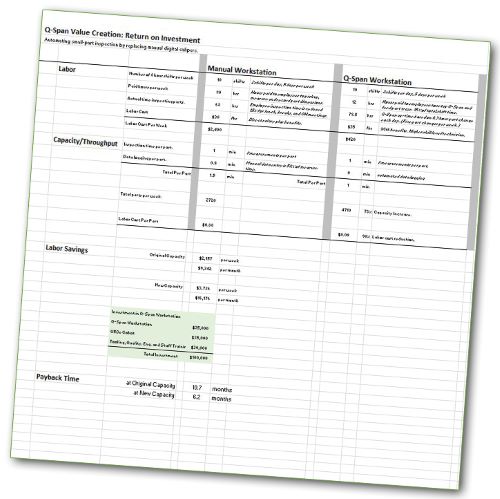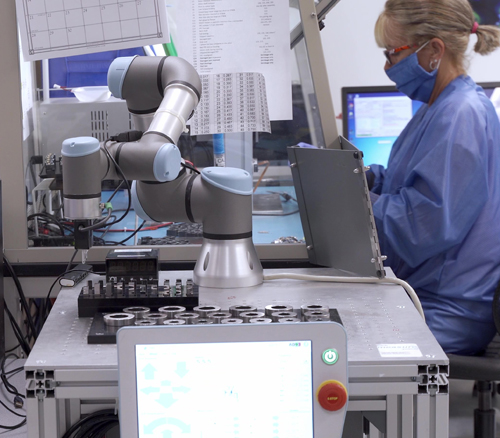So you’re considering automating manual gauging in manufacturing. Congratulations! If you’re like most companies, you need to estimate your return on investment (ROI) for the capital equipment. In this video, we show how you can calculate ROI for automation technology by considering your current costs, time spent on each process, and total costs for the investment. We explore the important distinction between payback period and ROI.
Whether it’s reduced labor cost, decreased risk, higher levels of quality or increased capacity, any tangible benefit can be quantified with an ROI calculation.
For example, let’s say a medical device manufacturer employs two full-time QC inspectors to measure a family of small parts manually with calipers, micrometers, and height gauges. Both inspectors work eight-hour shifts, five shifts per week. At a labor rate of $35/hour (fully weighted at about $42/hour, with taxes and benefits) this comes to a labor cost of $3,360 per week.
There are seven manufactured parts that are inspected using manual gauging.
| QC Time per Week | Part 1 | Part 2 | Part 3 | Part 4 | Part 5 | Part 6 | Part 7 | Total |
| Gauging time (sec) | 70 | 32 | 41 | 10 | 60 | 25 | 20 | 258 |
| Recording data (sec) | 25 | 12 | 15 | 5 | 15 | 5 | 5 | 82 |
| Inspection time per part (sec) | 95 | 44 | 56 | 15 | 75 | 30 | 25 | 340 |
| Inspection volumes per week (qty. parts) | 1,000 | 2,000 | 900 | 3,200 | 500 | 750 | 500 | 8,850 |
| Total time per week (hours) | 26.4 | 24.4 | 14.0 | 13.3 | 10.4 | 6.3 | 3.5 | 98 |
To manually inspect just these seven parts, at this volume, takes about 98 hours per week.
But after lunches, breaks and meetings, the two employees probably have only about 70 working hours available for inspection work – a shortage of 28 hours! Does this call for overtime, or hiring another person? If so, your labor rate in the ROI calculation is even higher – more reason to automate.
We work with companies that have far more than seven parts. No problem, the same calculation applies. With flexible automation, you can easily use the same automated work cell for all parts.
Addressing the labor hours shortage with automation
So you decide to automate the routine manual inspection work. Let’s roll the Q-Span Workstation in and see how your ROI looks.
Now, instead of measuring parts, your employees will set up and feed part trays to the Q-Span Workstation. The robotic system automatically picks parts from the trays, measures one or more features on each part, electronically logs the data, and places parts into pass, fail or sorted output trays based on the results.
These measurement tasks are now a small percentage of the employees’ shift time – perhaps 10-20%. This means that direct labor cost for QC part measurement can be reduced by at least 80%, while freeing the employees to do other QC work.
$3,360 x 80% = $2,688 labor savings per week
With an estimated cost of $125,000 for implementation of the Q-Span Workstation, you reach full payback in under a year.
$135,000 / $2,688 per week = 50.2 weeks payback
ROI vs. payback period
This brings up an important distinction between payback and ROI. Payback is how long it takes for you to recoup your initial investment – in this case, about 11 months. ROI, on the other hand, measures how well your investment performs over time.
At your payback period, you will have achieved a 100% ROI.
All things being equal, if you keep this system operating over three years, you will have experienced a 300% return on your investment, meaning it has paid for itself three times over. If you extend the system to measure additional parts or increase the number of shifts, that ROI becomes even greater.
Other benefits that can contribute to return on investment include:
- Greater capacity
- More flexible and scalable operations
- Higher part yields and reduced scrap
- Fewer bad parts shipped
- Continuous process improvement
- Increased employee retention as workers are relieved of mundane tasks
- Increased revenue due to higher productivity
- Increased customer satisfaction due to shorter production times and higher quality
Of course, there are a great number of variables when calculating your own ROI. These include the number of parts you measure per week, your employee’s salary and benefits, how long it takes them to measure each part, and how long it takes a Q-Span System to do the same task, which is generally the same or faster. Contact us and we can help you work through your specific details to estimate your ROI.
Learn more
Calculating ROI for a Q-Span Workstation
Includes two scenarios for deploying automation: Remain at the same capacity and reduce labor costs, or use automation to increase capacity. Read Calculating ROI for a Q-Span Workstation
Beyond ROI to Value Creation
By calculating ROI based on labor savings alone, we ignore the many ways in which automating QC inspection creates real value for your company. These value-creation sources range from the intangible, such as increased employee engagement, to hard numbers such as reducing total costs. See seven value-creation benefits from automation.
See Q-Span Gauging Systems at The Quality Show
October 24-26, 2023 | Chicago, IL
Booth #1535
Related blog posts

Calculating ROI for a Q-Span Workstation
Includes two scenarios for deploying automation: Remain at the same capacity and reduce labor costs, or use automation to increase capacity.

Beyond ROI to Value Creation
By calculating ROI based on labor savings alone, we ignore the many ways in which automating QC inspection creates real value for your company. Here are seven.

